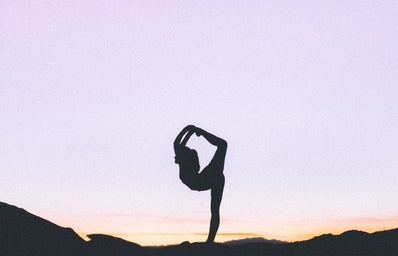Sometimes, it can be hard (really hard) to admit that your parents know what’s best for you. Remember when they used to yell, “Sit up straight!” and “Don’t slouch!”? However annoyed you felt then, it’s time to accept the fact that they were right. Along with looking confident, sitting and standing straight makes for a healthier body. Wish you had listened to Mom? Don’t worry; it’s not too late to fix your posture! We spoke with several experts to get their tips and tricks on how to straighten up.
What is Good Posture?
Posture is all about body alignment! Aaron Lundgaard, a Michigan-based chiropractor, says that normal, neutral posture is having your head, shoulders, and hips level. When standing up, imagine drawing a straight line from your ear to your shoulder, your hip, and finally, to your ankle. Your weight should be distributed on both of your feet equally. When sitting down, your feet should be on the floor in front of you, and your spine should rest flat against the back of your chair.
Katey Balint, a massage therapist based in Ann Arbor, says there are visual cues to look for when trying to correct your posture. “With poor posture, you curl forward and your shoulders come in, so you get that hunched look,” Balint says. To avoid having a hunched back while sitting, pay attention to where your knees and hips are positioned. “When you’re sitting down, your hips should be higher than your knees so that your spine straightens out, and you are forced to sit up straighter as a result,” she says. While standing, let your arms hang by your sides. Your palms should face the outside of your legs if you are standing correctly. According to Balint, people who have rounded shoulders will hunch over and have just their thumbs facing their legs.
Get Moving
Hours of sitting slouched over in lecture, or maybe just bumming on the couch on a Saturday, can take a toll on your body and your posture. Andrew Haig, M.D., a professor of physical medicine and rehabilitation at the University of Michigan, says that “the body is healthiest when it is in action and moving.” Haig says that moving for a few minutes after sedentary activity will help alleviate stiffness and work to restore your body’s posture. To fight the slouch, try taking a five- or 10-minute walk between classes or during a break at your internship.
Find the Perfect Chair (Or Go Chair-less)
Sick of slipping into the sinkhole that is your couch? Are the 100-year old chairs in the library not cutting it? We feel your pain (literally). Finding the perfect seat can be tricky, Haig says, but it will help you improve and maintain a healthy posture as well as lessen the frustrating back pains that exam cram sessions or lazy Saturdays often cause.
When looking for the right chair, Haig says students should consider the height, along with what it’s made of. When sitting, your desk or table should be at elbow height, which allows your shoulders to relax and promotes a straighter back. We all know that your beanbag or butterfly chair is comfortable, but an ergonomic chair will work wonders on your posture!
An extreme solution: would you consider going chair-less? Standing while doing work (occasionally) will teach you to maintain good posture and enhance blood flow and circulation to the rest of your body.
Practice Yoga
Along with reducing stress and promoting self-awareness, yoga is perfect for strengthening and straightening up your body. Diana Hough, operations manager at A2 Yoga, says that yoga’s influence is invaluable. “When you’re working with yoga, you are strengthening your core muscles, and it’s the muscles that help with body alignment and stability of your bones,” Hough says. “Yoga itself teaches you how to reconnect with body movement and flexibility, which is very important for posture.”
It can be intimidating going into a studio alone for the first time, so grab a friend and get yoga-ing together! Groupon is a great place to look for cheap classes in your area. If you can’t find time to go to a studio, there are still moves to practice on your own at home. Hough provided us with beginner poses that will help improve your posture!
Mountain pose
For this pose, “you’re working with your deeper back muscles and you’re maintaining alignment with control to your sacrum, a bone at the base of the spine,” Hough says. Simple steps for mountain pose:
- Stand with your feet and legs together
- Keep your chin parallel to the ground and your arms at your sides
- Close your eyes, and feel your body as it balances from the top of your head to your pelvis
- Breathe slowly
- Hold for 30 seconds
Wide-legged forward bend
“This counterpose has you hanging upside down so that gravity is pulling the muscles in your back,” Hough says. “When you’re doing the forward bend and you bring yourself to stand up (back into mountain pose), you will experience an elongated feeling.” Simple steps for wide-legged forward bend:
- Stand with your feet spread apart
- Lean your torso forward (so that you’re hanging upside down)
- Place your hands on the ground below your shoulders
- Hold for 15-30 seconds
Stretch it Out
Along with yoga and exercise, Lundgaard says it is essential for students and interns to stretch in order to maintain a healthy spine, which means a healthy posture! Sorry, collegiettes — slouching is a big no-no. “Environmental stressors and repetitive stress causes changes in spinal joint position and reduced spinal movement. If these changes are allowed to become our ‘new normal’ position, a cascade of problems occur,” he says.
Lundgaard gave us a few examples of simple back stretches that can be done at home, or even at your desk. He recommends completing these stretches after every hour to two hours of sitting. Along with keeping your spine healthy, stretching during yout lunch break has other perks. “This also helps with retention during [working],” he says. “Our brain retains materials better at the start and stop of a study session, and so more breaks equals more material memorized.” We like the sound of that! Next time you need a break, give one of these a try:
Stretch 1
Stand on the floor facing a chair. Lay one of your legs straight on the chair. Lean forward with a flat back and hold for 5-10 seconds. Switch legs, and repeat.
Stretch 2
Sitting in your chair, spread your knees apart. Lower yourself to the ground so that your hands touch the floor. You should feel a comfortable stretch in your lower back. Hold for 10 seconds and push up with your arms. Repeat 5 times.
Good Posture Never Sleeps
When you’re tired, worrying about how proper you look is probably pretty low on your list of priorities. At the same time, it’s important to realize that your posture still matters, even in the comfort of your own bed! Ever wake up with a kink in your neck? What about those horrible back pains from sleeping at the wrong angle? Your mattress and pillows play a big role in making things comfortable and improving your posture. The American Chiropractic Association recommends using a pillow that will allow your head to rest comfortably, staying aligned with your shoulders and hips, to avoid neck or back pains.
Alright, admit it: your parents were right, and they always will be. If you’re guilty of slouching (as many collegiettes are!), it’s not too late to start practicing better posture. With these tips, you will go from slouching to straight up in no time! Have any suggestions or tips of your own to share? Leave a comment below!

